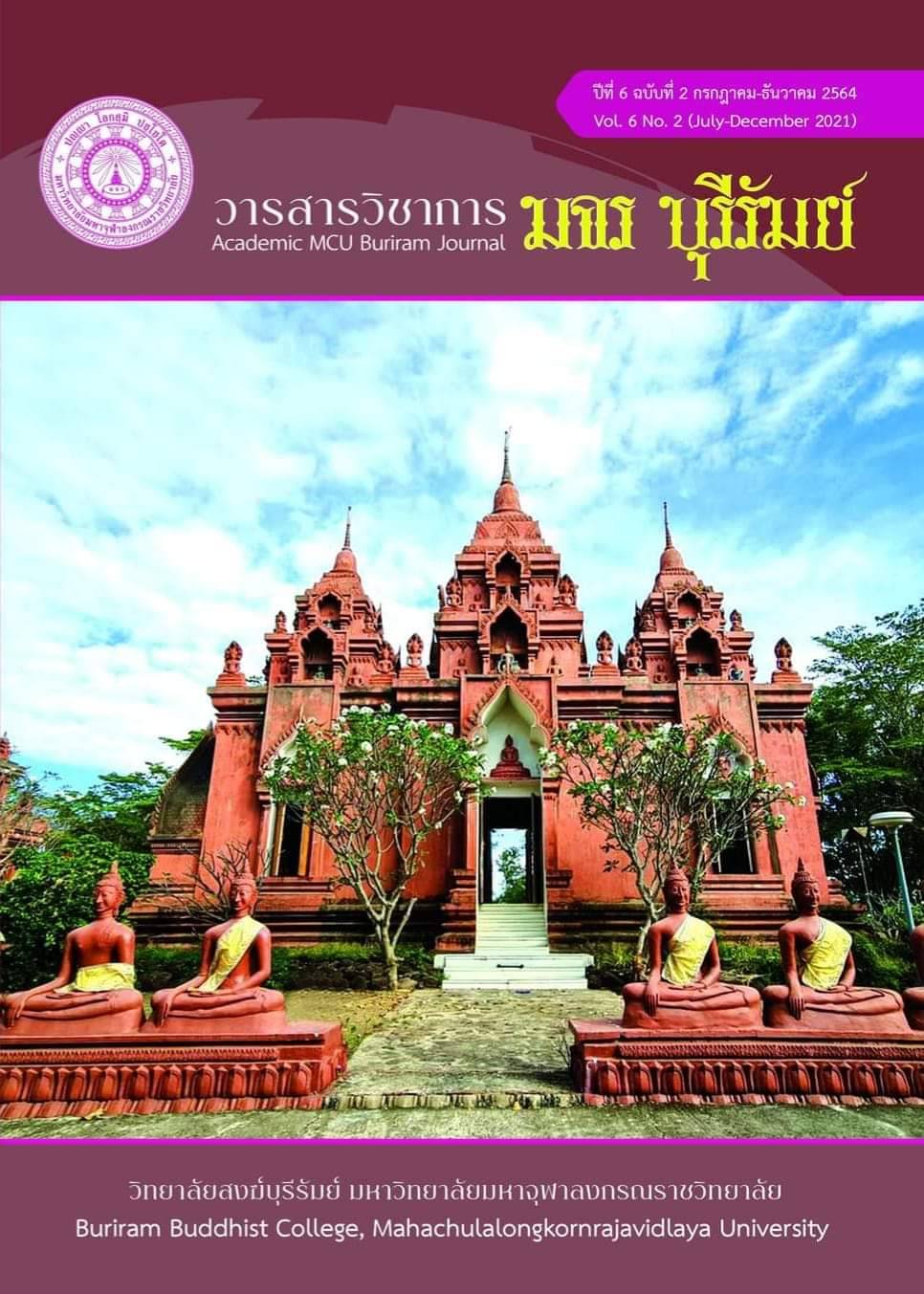Guidelines for Developing Tourism Potential of Ban Salangpun Community, Salangpun Sub-District, Lamplaimat District, Buriram Province
Keywords:
Potential Development, Community Tourism, Ban Salangpan, Buriram ProvinceAbstract
The purposes of this study were 1) to study the potential of Ban Salangpun community, Salangpun sub district, Lamplaimat district, Buriram province, and 2) to search for guidelines of developing tourism potential of this community. The researcher collected the data through In-dept Interview, Focus Group, Walk-in Survey, and Participatory Observation. The results revealed that Salangpun community has 3 tourism potentials: 1) community cultures, 2) local goods and food, and 3) tourist attractions. 1) The Potential of Community Cultures: The ancient people of this community were Thai-Chinese races. They settled there and their culture was the identity of the community. 2) The Potential of Local Goods and Food: The community’s signature goods and food for the tourists were cantaloupe and: Larb Peking Duck, Panang local Chicken, Tom Klong, Organic Eggplant Soup, etc. They were important highlight in attracting tourists. 3) Lastly, Potential of Tourist Attractions: Salangpun train station, Saiyud market, Sangjun learning center, and an ancient 100 years old - Thai-Chinese barn, etc. All those places have had history and relation of community culture since the past time. These history and cultures become 3 guidelines for developing the tourism potential of this community: 1) guidelines for developing community tourism through guide training, 2) guidelines for developing public relation potential, and 3) guideline for building partners in community tourism management.
References
กองวิจัยการตลาด การท่องเที่ยวแห่งประเทศไทย. (2561). ศึกษาพฤติกรรมนักท่องเที่ยวชาวไทยที่มีศักยภาพในการใช้จ่าย. กรุงเทพฯ: รายงานฉบับสมบูรณ์กองวิจัยการตลาด การท่องเที่ยวแห่งประเทศไทย.
กลุ่มประวัติศาสตร์ คณะมนุษยศาสตร์และสังคมศาสตร์ มหาวิทยาลัยราชภัฏบุรีรัมย์. (2562). ท้องถิ่นศึกษา. กรุงเทพฯ: พี.เอส.เพรสจำกัด.
ดำรงค์ ฐานดี. (2544). สังคมและวัฒนธรรมจีน. พิมพ์ครั้งที่ 2. มหาวิทยาลัยรามคำแหง.
เทิดชาย ช่วยบำรุง. (2552). บทบาทขององค์กรปกครองส่วนท้องถิ่นกับการพัฒนาการท่องเที่ยวอย่างยั่งยืน. กรุงเทพฯ: คณะรัฐมนตรีและราชกิจจานุเบกษา.
นาตยา เกตุสมบูรณ์ และ วันทนา เนาว์วัน. (2562). ศักยภาพด้านการท่องเที่ยวเพื่อการพัฒนาหมู่บ้านท่องเที่ยว หมู่บ้านหนองสรวง ตำบลกระแซง อำเภอบางไทร จังหวัดพระนครศรีอยุธยา. วารสารสมาคมสถาบันอุดมศึกษาเอกชนแห่งประเทศไทย ในพระราชูปถัมภ์สมเด็จพระเทพรัตนราชสุดาฯ สยามบรมราชกุมารี, 25(1), 81-93.
พรรณ์ธิดา เหล่าพวงศักดิ์ ธนินท์รัฐ รัตนพงศ์ภิญโญ และ อารี ผสานสินธุวงศ์. (2560). การพัฒนารูปแบบการท่องเที่ยวสำหรับการเรียนรู้วิถีเกษตรเพื่อยกระดับศักยภาพการท่องเที่ยวเชิงสร้างสรรค์ในจังหวัดกาญจนบุรี. ได้รับงบประมาณสนับสนุนจากคณะกรรมการวิจัยแห่งชาติ (วช.) และสำนักงานกองทุนสนับสนุนการวิจัย (สกว.).
พิมพ์ระวี โรจน์รุ่งสัตย์. (2556). การท่องเที่ยวชุมชน. พิมพ์ครั้งที่ 2. กรุงเทพฯ: โอเดียนสโตร์.
ฟองจันทร์ หลวงจันทร์ดวง สุรชัย กังวล และ วราภรณ์ นันทะเสน. (2561). ศักยภาพชุมชนต้นแบบการท่องเที่ยวเชิงสร้างสรรค์อย่างยั่งยืน. วารสารอิเล็กทรอนิกส์การเรียนรู้ทางไกลเชิงนวัตกรรม, 8(2), 52-83.
ฤทพร พลบุญ. (2556). การค้าหมูในสุรินทร์ พ.ศ. 2469-2503. วารสารประวัติศาสตร์, 6(1), 120-128.
วัชระ เชียงกูล และ เทิดชาย ช่วยบำรุง. (2560). พฤติกรรมการท่องเที่ยวของท่องเที่ยวเชิงกีฬา จังหวัดบุรีรัมย์. วารสารมนุษยศาสตร์และสังคมศาสตร์ มหาวิทยาลัยราชภัฏอุบลราชธานี, 8(1), 90-109.
ศักดิ์ชาย สิกขา. (2555). สภาพปัจจุบัน และปัญหา พิพิธภัณฑ์พื้นบ้านอีสาน. อุบลราชธานี: ศิริธรรมออฟเซ็ท.
สมศักดิ์ สามัคคีธรรม. (2564). ธรรมาภิบาลและความรับผิดชอบทางสังคม. พิมพ์ครั้งที่ 2. กรุงเทพฯ: สถาบันบัณฑิตพัฒนบริหารศาสตร์.
อริสรา เสยานนท์. (2560). การประกอบการในอุตสาหกรรมการท่องเที่ยว. กรุงเทพฯ: ซีเอ็ดยูเคชั่น.
อุทิศ ทาหอม สำราญ ธุระตา ชุลีพร บุ้งทอง และคเนศ วงษา. (2561). รูปแบบการเพิ่มมูลค่าผลิตภัณฑ์อาหารพื้นถิ่น "ตำเปียงทรงเครื่อง" เพื่อสร้างความเข้มแข็งของเศรษฐกิจชุมชนบ้านเสม็ด ตำบลหนองเต็ง อำเภอกระสัง จังหวัดบุรีรัมย์. วารสารพัฒนาสังคม, 20(2), 35-62.
อุทิศ ทาหอม และ สุนันท์ เสนารัตน์. (2561). การประยุกต์ใช้ทุนทางวัฒนธรรมกับการพัฒนาชุมชนท้องถิ่นอีสาน. วารสารวนัมฎองแหรกพุทธศาสตรปริทรรศน์, 5(1), 15-24.
Digital Thailand. (2020). สถิติ Digital Thailand ประจำปี 2020. สืบค้นจาก http://gg.gg/ui6uq. เมื่อวันที่ 6 ธันวาคม 2563.
Giampiccoli, A. (2020). A conceptual justification and a strategy to advance community-based tourism development. European Journal of Tourism Research, 25(3), 1-20.
Pedersen, S. B. (2020). A passport to peace? Modern tourism and internationalist idealism. European Review, 28(3), 389-402.
Rafi, F., & Herdiansyah, H. (2020). The impact of Koja cliff development on social-cultural and economic: case of community-based tourism, Banten, Indonesia. GeoJournal of Tourism & Geosites, 28 (1), 164-175.
Szente, V., Osiako, P. O., Nagy, M. Z., Pintér, A., & Szigeti, O. (2021). Community Based Ecotourism IN Hungary: Citizens Perceptions Towards The Roma Community. GeoJournal of Tourism and Geosites, 34(1), 233-239.
Downloads
Published
How to Cite
Issue
Section
License
ทัศนะและความคิดเห็นที่ปรากฏในบทความวารสารฉบับนี้ถือเป็นความรับผิดชอบของผู้เขียนบทความนั้น ไม่ถือเป็นทัศนะและความรับผิดชอบของบรรณาธิการ





